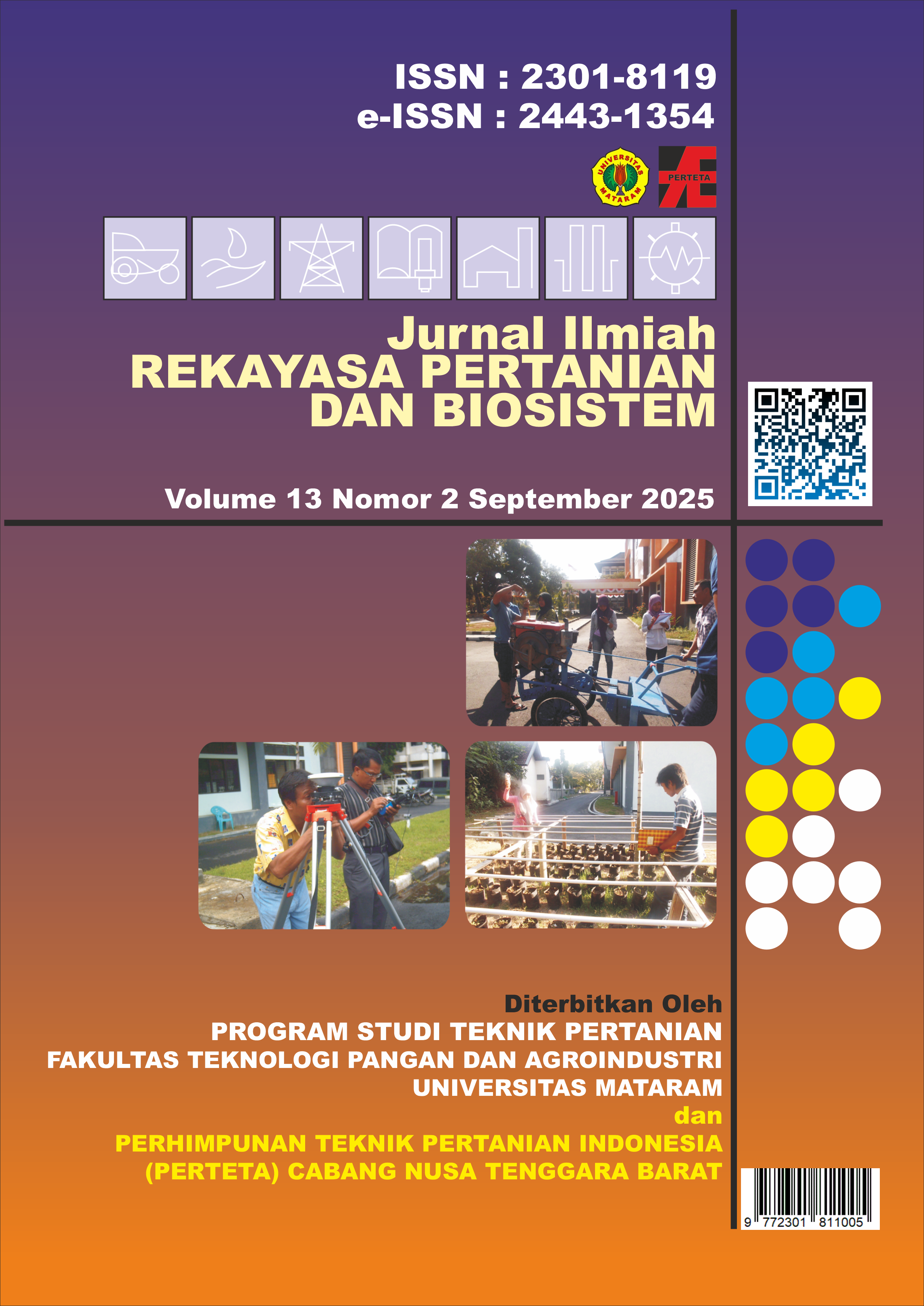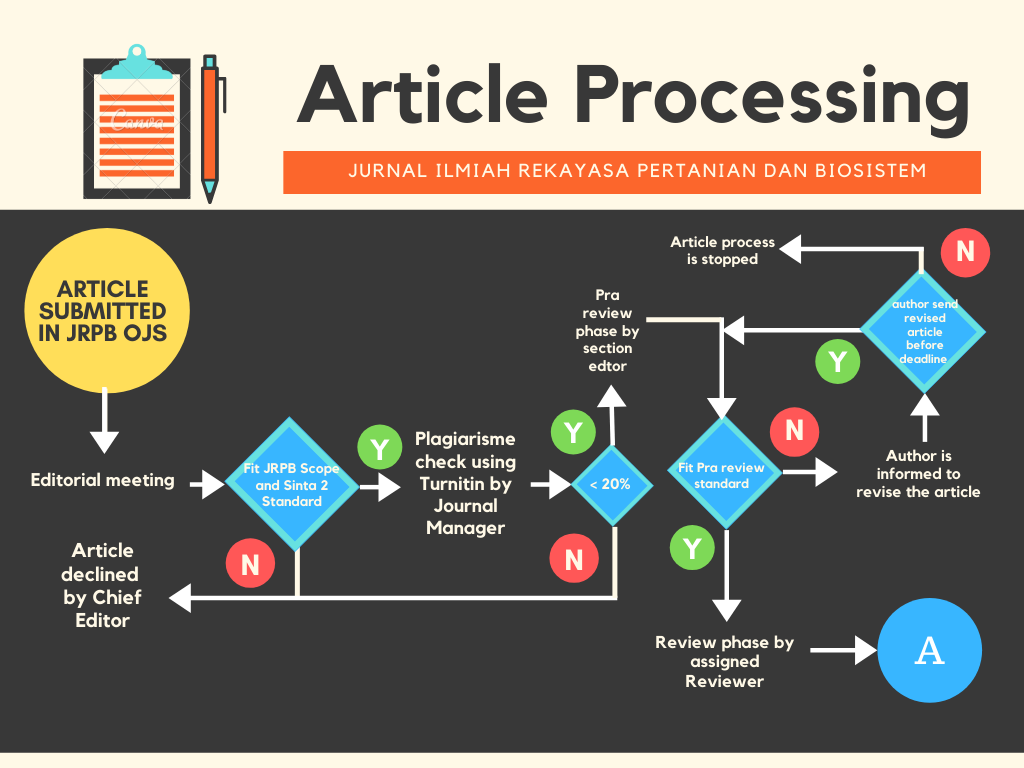Characterization of Bioplastic from Cellulose Acetate Empty Bunches Oil Palm and Canna Bulb Flour (Canna edulis Ker) with Addition of Variations of Glycerol
Authors
Musthofa Lutfi , Gunomo Djoyowasito , Bambang Dwi Argo , Lita Puspita Rizka PerdanaDOI:
10.29303/jrpb.v13i2.1167Published:
2025-09-29Issue:
Vol. 13 No. 2 (2025): Jurnal Ilmiah Rekayasa Pertanian dan BiosistemKeywords:
bioplastics, canna tuber starch, cellulose acetate, glycerolArticles
Downloads
How to Cite
Downloads
Abstract
Bioplastics are environmentally friendly materials that serve as alternatives to synthetic plastics, capable of being decomposed by microorganisms. Starch, commonly sourced from tubers such as canna tubers, is one of the primary natural components used in bioplastic production. This study utilized a completely randomized factorial design with glycerol as a plasticizer and cellulose acetate from Oil Palm Empty Fruit Bunches (OPEFB) as a reinforcement agent. Glycerol was varied at concentrations of 1, 2, 3, 4, and 5 ml, while cellulose acetate OPEFB was varied at 1, 1.5, 2, 2.5, and 3 g. The resulting bioplastics underwent mechanical testing, including tensile strength, elongation, elasticity, water absorption, solubility, and biodegradability. The highest tensile strength (20.56 MPa) was observed with 2 ml glycerol and 1.5 g cellulose acetate OPEFB. The best elongation (33.33%) occurred with 4 ml glycerol and 1 g cellulose acetate OPEFB. Maximum elasticity (2.86 MPa) was achieved with 2 ml glycerol and 2.5 g cellulose acetate OPEFB. Optimal water absorption (12.54%) was recorded with 1 ml glycerol and 1 g cellulose acetate OPEFB, while the highest solubility (43.97%) was observed with 5 ml glycerol and 3 g cellulose acetate OPEFB. The greatest biodegradability (88.75%) was achieved with 5 ml glycerol and 1.5 g cellulose acetate OPEFB. These findings highlight the potential of starch-based bioplastics reinforced with cellulose acetate OPEFB to achieve desirable mechanical and environmental performance characteristics.
References
Amin, A., Mohd Sauid, S., Musa, M., & Hamid, K. (2017). The effect of glycerol content on
mechanical properties, surface morphology and water absorption of thermoplastic films
from Tacca leontopetaloides starch. Jurnal Teknologi, 79(1), 10.
https://doi.org/10.11113/jt.v79.11327 DOI: https://doi.org/10.11113/jt.v79.11327
Agustin, Y E and K S Padmawijaya. (2016). Synthesis of Bioplastics from Chitosan-Starch of
Kepok Banana Peels with Addition of Additives. Jurnal Teknik Kimia, Vol. 10, No. 2
Chinomso M. Ewulonu and Isaac O. Igwe. (2012). Properties of Oil Palm Empty Fruit Bunch
Fibre Filled High Density Polyethylene. International Journal of Engineering and
Technology, Vol. 3 (6), 2011-2012, 458-471 DOI: https://doi.org/10.1111/j.1751-9020.2012.00466.x
Dewanti, D P. (2018). Potential of Palm Empty Fruit Bunches Cellulose, Environmental
Friendly Bioplastic Raw Materials. Jurnal Teknologi Lingkungan Vol. 19, No 1
Dias, A. B.; Müller, C.M.O.; Larotonda, F.D.S.; and Laurindo, J. B. (2010). Biodegradable Films
Based on Rice Starch and Rice Flour. Journal of Cereal Science, 51, pp. 213–219.
E. Sari; M. Effendy; N. Kanani; Wardalia; Rusdi. (2018). Utilization of Empty Fruit Bunch Fiber
of Palm Oil Industry for Bio-Hydrogen Production. International Journal on Advance
Science EngineeringInformation Technology, Vol. 8 No. 3 ISSN: 2088-5334 pp. 842-848
Garcia Ma; Martino Mn; Zaritsky Ne. (2000). Lipid Addition to Imporve Barrier Properties Of
Edible Starch - Based Films and Coating. Journal of Food Science, 65(2):195-206.
Jonoobi; M, J Harun; A P Mathew; M Z B Hussei; and K Oksman. (2009). Preparation of
cellulose nanofibers with hydrophobic surface characteristics. Journal Cellulose, Vol. 17:
–307
Lailyningtyas D I.; Lutfi, M.; Ahmad, A. M. (2020). Mechanical Test of Bioplastics Made from
Canna Edulis Starch with Variations of Cellulose Acetate and Sorbitol. Journal Keteknikan
Pertanian Tropis dan Biosystem, 8(1): 91–100
Li Loo; Milly Mei; Rokiah Hashim; and Cheu Peng Leh. (2012). Recycling of Valueless Paper
Dust to a Low-Grade Cellulose Acetate: Effect of Pretreatments on Acetylation. Bio
Resources, 7(1), pp: 1068-1083.
Lutfi M.; Sumarlan S. H.; Susilo B.; Wignyanto. (2016). Mechanical characteristics of
biodegradable plastic using elephant foot yam (Amorphophallus paenifolius Var. hortensis)
and glycerol. Trends in Carbohydrate Research, 8(3): 47–51
Lutfi M; Sumarlan S.H.; Susilo B.; Wignyanto. (2017). The glicerol effect on mechanical
behaviour of biodegradable plastic from the walur (Amorphophallus paenifolius Var.
sylvestris). Natural Environment and Pollution Technology, 16(4): 1121–1124
M.A. Garcia; M.N. Martino; N.E. Zaritk.(2000). Barrier properties of edible starch-based films
and coatings. J Food Sci, 65 (6), pp. 941-947
Mekonnen, T; P Mussone; H Khalilband; and D Bressler. (2013). Progress in bio-based plastics
and plasticizing modifications. Journal of Materials Chemistry A, Vol. 1: 13379–13398
Munthoub, D I and W A Rahman. (2011). Tensile and Water Absorption Properties of
Biodegradable Composites Derived from Cassava Skin/Polyvinyl Alcohol with
Glycerol as Plasticizer. Journal Sains Malaysiana, Vol. 40: 713–718
Murata, K., Sato, K., & Sakata, Y. (2004). Effect of pressure on thermal degradation of
polyethylene. Journal of Analytical and Applied Pyrolysis, 71(2), 569–589.
https://doi.org/10.1016/j.jaap.2003.08.010. DOI: https://doi.org/10.1016/j.jaap.2003.08.010
Ogawa, T, B Ding, Y Sone, dan S Shiratori. (2007). Super-Hydrophobic Surfaces of Layer-ByLayer Structured Flm-Coated Electrospun Nanofibrous Membranes. Journal
Nanotechnology Vol. 18 (16) DOI: 10.1088/0957-4484/18/16/165607 DOI: https://doi.org/10.1088/0957-4484/18/16/165607
Phuong, V T; S Verstichel; P Cinelli; I Anguillesi; M B Coltelli; and A Lazzeri. (2014). Cellulose
Acetate Blends – Effect of Plasticizers on Properties and Biodegradability. Journal
Renewable Material, pp. 1-7
Sadritdinov, A R.; Khusnullin, A.G.; Psyanchin, A.A.; Zakharova, E. M.; Zakharov, V. P.;
(2020) Physical and Mechanical and Thermophysical Properties of Polymer Composites
Based on Recycled Polypropylene Filled with Rice Husk. Periódico Tchê Química, Vol. 17
(n°35) pp 703-712
Sahari, J; M L Sanyang; S M Sapuan; M Jawaid; M R Ishak. (2015) Effect of Glycerol and
Sorbitol Plasticizers on Physical and Thermal Properties of Sugar Palm Starch Based
Films. Sabah: Universiti Sabah Malaysia. Conference: 13Th International Conference on
Environment, Ecosystems, and Development (EED ’15), At: Kuala Lumpur, Malaysia
Salikova, N S.; Bektemissova, A U.; Nazarova, V. D. ; Begenova, Ba E. ; Ostafeichuk, N V.
(2020). Preparation of Mixed Hydrogels Based on Biopolymers and The Study of Their
Rheological Properties. Periódico Tchê Química, Vol. 17 (n°35) pp. 25-40
Sanyang, M L; M Sapuan; M Jawaid; M R Ishak; and J Sahari. (2015) Effect of Plasticizer
Typeand Concentration on Physicalproperties of Biodegradable Films Based on Sugar
Palm (Arenga Pinnata) Starch for Food Packaging. Journal Food Science and Technology,
Vol. 53: 326–336
Siagian, M; Maulida; and Tarigan. (2016). Production of Starch Based Bioplastic from Cassava
Peel Reinforced with Microcrystalline Celllulose Avicel PH101 Using Sorbitol as
Plasticizer. Journal of Physics: Conference Series 710
Souza, V. G. L., & Fernando, A. L. (2016). Nanoparticles in food packaging: Biodegradability
and potential migration to food—A review. Food Packaging and Shelf Life, 8, 63–70.
https://doi.org/10.1016/j.fpsl.2016.04.001 DOI: https://doi.org/10.1016/j.fpsl.2016.04.001
Wahyuningtiyas, N E, H Suryanto. (2017). Analysis of Biodegradation of Bioplastics Made of DOI: https://doi.org/10.17977/um030v1i12017p024
Cassava Starch. Journal of Mechanical Engineering Science and Technology, Vol. 1 No. 1
Zavareze, E; da R. Pinto; V.Z., Klein; B. El Halal, S.L.M., Elias, M.C., Prentice-Hernández, C.,
et al. (2012). Development Of Oxidised and Heat–Moisture Treated Potato Starch Film.
Food Chemistry, 132 (1), 344–350.
License
Copyright (c) 2025 Musthofa Lutfi, Gunomo Djoyowasito, Bambang Dwi Argo, Lita Puspita Rizka Perdana

This work is licensed under a Creative Commons Attribution-ShareAlike 4.0 International License.
Authors who publish with this journal agree to the following terms:
- Authors retain copyright and grant the journal right of first publication with the work simultaneously licensed under a Creative Commons Attribution License 4.0 International License (CC-BY-SA License). This license allows authors to use all articles, data sets, graphics, and appendices in data mining applications, search engines, web sites, blogs, and other platforms by providing an appropriate reference. The journal allows the author(s) to hold the copyright without restrictions and will retain publishing rights without restrictions.
- Authors are able to enter into separate, additional contractual arrangements for the non-exclusive distribution of the journal's published version of the work (e.g., post it to an institutional repository or publish it in a book), with an acknowledgement of its initial publication in Jurnal Ilmiah Rekayasa Pertanian dan Biosistem (JRPB).
- Authors are permitted and encouraged to post their work online (e.g., in institutional repositories or on their website) prior to and during the submission process, as it can lead to productive exchanges, as well as earlier and greater citation of published work (See The Effect of Open Access).










